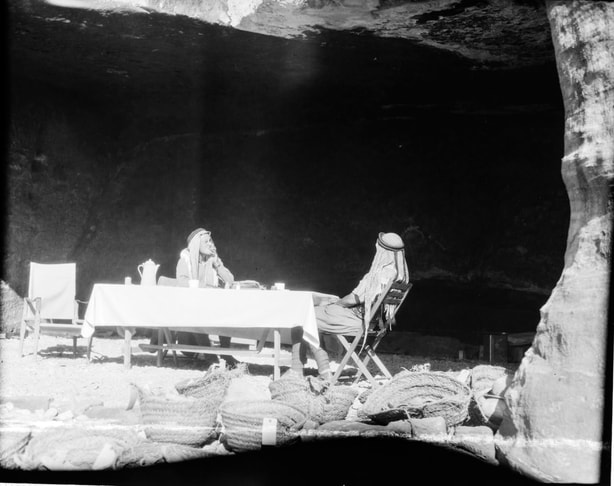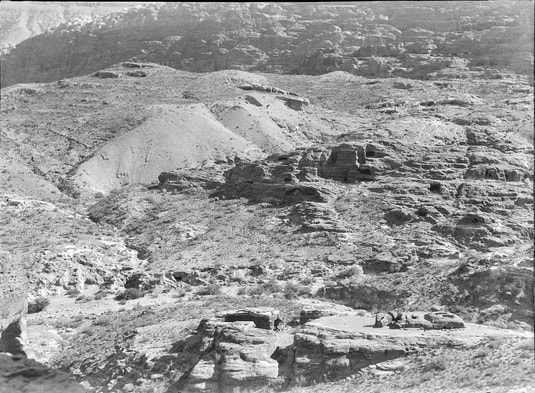|
[by Agnes Conway and George Horsfield] Dr. Nielsen spent the day working at the Sanctuaries on El Habis, and felt that he had discovered enough in one morning to justify his journey. This complex of cult monuments, all orientated to the west, seem to him to be the earliest Arabian sanctuaries, circa the 2nd millennium B.C. He thinks that the bulls heads on the so-called “pulpit” and the cone shaped top, somewhat resembling a coil, of snakes, are of human workmanship, though much weathered. (He turned this down afterwards). A.E.C. spent the morning and afternoon exploring the Wady El Tughra. Below El Habis, S of the sanctuaries, she found what might almost be called a cemetery of shaft graves, some leading into large tomb chambers below. All were of solid construction and considerable depth, but the roofs in all cases had gone and the contents were rifled. One shaft grave had 3 small detached obelisks near it, and the holes for the bases stood at the head of the grave 1. The graves on the opposite side of the Wady under El Bijara are much later. Two sumptuous Nabataean temple graves have later partition walls of large stones, regularly built (prob. Bedouin?). One large tomb with a niche for a single grave has only a small hole knocked out of the slab and might be worth exploring for its contents. Following the Wady southwards a large irregular lump of sandstone in the middle (the Kegelberg) is also a collection of shaft graves, and further on on the western side are a few shaft graves in front of some of the largest Hellenistic tombs. The green plateau between the Wady and the W. face of El Biijara is a mass of large worked stones, probably Greco-Roman and looked to her like remains of the town. Where the Wady en Mer runs into the Wady el Tughra are a few rock-hewn caves, almost entirely silted up with sand, which might be worth excavation. G. H. started digging in mound S.W. Zubb Pharoon [sic], on the part that lies above Dalmans [sic] “Byzantine” Wall. It is covered with Byzantine pottery but the steps cut in the side of the mound produced very little. The mound in this part is composed of sand and a certain amount of burnt debris, probably from wood fires, but contained no charcoal. The sand is loose and the digging had to be done with caution for fear of a land slide. In the afternoon moved further South, where the debris is deep, and higher up the mound, which is apparently surmounted by a fortified wall which is not shown in Dalman’s plan. It breaks out from the Byzantine wall then turns until it meets the rock, with a shaft tomb. Below this lies another with slabs in place, one being broken so that you can peer in. It is partially filled with debris, and seems to have a chamber on either side. The pottery finds were poor, but a deep cutting may be interesting. The evidence so far obtained points to the wall being pre-Byzantine, as it is buried in debris of this period. Today the Camp was finished. It is situated in the Wadi Deir, in caves on both sides. In the West is the cookhouse, Living Room, W.C. and stables, and beyond a Bathroom. Dr Nielsen and Miss Conway are accommodated in tents. On the East is the Guardroom, which is also used as a Store House; adjoining is a small cave for G.H. and next door is the Guest Room. It is fairly compact, and the guard room covers all points of approach.
Many deficiencies have been discovered in the equipment, which was reduced as much as possible. These are being taken in hand, and Thos. Cook and Son’s camp, in the person of the Manager, has been most helpful. It is impossible to buy anything at Elgi, except the poorest things. No vegetables are obtainable. Milk is procurable. Chickens and sheep have to be got from the Arabs some miles away. Arrangements are beginning to work, so that all the attention of the Expedition may be given to the work of exploration. __ [Footnote]: 1. These are probably not holes for obelisks, but the ordinary ones for offerings. Mr Horsfield excavated these shaft graves later on. Reference: [unsigned, but by Agnes Conway and George Horsfield] 1929 (transcribed by A. Thornton). Petra Exploration Fund Diary. "Business Papers to be Kept", Horsfield Collection Box 8, UCL Institute of Archaeology, 26 March: 6-9. [by George Horsfield and Agnes Conway] G. H. Changed digging back to Katooti [see 4 April entry] – spent morning writing up Hadrianic North part of city wall. Afternoon on dig which I don’t in the least understand. Pottery all [? In pencil] A.E.C. photographed in the morning in El Farasa W. & El Farasa E. and found an enormous cistern near the mouth of Wady en Mer. She took the interiors of 2 tombs with sarcophagi under the ceiling with the half-plate camera in afternoon, in El Farasa W.
Reference: Horsfield, G. [and Conway A.] 1929 (transcribed by A. Thornton). Petra Exploration Fund Diary. "Business Papers to be Kept", Horsfield Collection Box 8, UCL Institute of Archaeology, 9 April: 30. [possibly George Horsfield and Agnes Conway]
Removed from Ma’aisera to Syagh [sic] and cleared two rooms and seven graves and three Tomb chambers – found nothing. Operating on a shaft grave which has produced so far from the shaft a glass bottle – a fragment of lamp – and a piece of pierced stone-diamonds which has probably formed part of a window grill. Ma’aisera has belied its hoary appearance. It seems certain from the facts and evidence obtained that it dates from near 1 BC or 14 A.D. allowing a margin on either side. The Assyrian Tombs do not seem more ancient. Two arrangements of insides were noticed – a single grave deep and large at the side – which took nearly half floor area – or this in combination with niches at the back for burials, or alone. The Tombs with Dushara symbols (Triple Dushara Tomb) from the fact of cremation were the most interesting – but as no pottery or object was found then date is uncertain – but in the case of others (No. 3 below particularly) a large amount of “burnt” bones was obtained in fragments – and the signs of burning have been noted on several occasions – but never with the conclusive evidence as to means as that obtained in Triple Dushara in five cases. The use of sand has obtained in every tomb or grave opened which was wholly or partially undisturbed – and the disappearance of the corpse caused the sand to fall and in several cases where the covers were in place there was a space between the sand and the cover. The burial images were various – the austere Dushara method with nothing – with the symbol carved in the wall above and at its side a lamp niche – or a profusion of common pots – an iron ring and a bronze cylindrical vessel or just a juglet at the feet. A.E.C. spent the morning photographing in the Farasas; exploring the Wady en Iver [sic], where Dalman calls a room with a horned altar scratched on the walls a sanctuary, and trying in vain to find the inscription to the Divine Obodat at the end of the En Iver [sic] Valley. Neither Brunnow nor Dalman give instructions that can be followed on the spot. Photographed in the Siyagh in the afternoon and went to the dig on El Habis with Mr Horsfield. Reference: [unsigned, possibly Horsfield, G. and Conway, A.] 1929 (transcribed by A. Thornton). Petra Exploration Fund Diary. "Business Papers to be Kept", Horsfield Collection Box 8, UCL Institute of Archaeology, 1 May: 63-65. [possibly by Agnes Conway]
Mr Horsfield went to Maar [sic] to get money and started packing pottery. AEC went to Zibb Atuf and got the larger cistern dug out. She brought back all the fragments of pottery, which include most of the types from Byzantine to Nabataen and Greco-Roman already found here. She then dug a square yard in front of the small cistern to see whether there was an artificial channel for the liquids from the round altar. A wall 50 centimetres thick was found running at right angles from the corner of the cistern to the natural stone. Immediately in front of the cistern, at the 40 cm level, a stratum of burning was struck, full of burnt pottery, which Mr H declared to be Nabataean. The outflow of the liquid must have been stopped by the wall, one stone of which is still in position standing above the ground. She went down by the S. way to the Wady En Mer and the Hrabet-en-Mer, where the Obodat inscription is. This shrine to the Divine Obodat, if it is one, looks exactly like a house. What Dalman calls a statue and which should probably be translated “image” is clearly an omphalos in a niche; the spot above it, said by Dalman to be the hollow for the upper part of the statue, being the last remains of the fine tooling of the niche above the omphalos. The stone on which the inscription is, occupies the position of a 9 inch vertical beam in relation to the ceiling, and covers two yards to the front of the niche. The beam, squared and tooled its whole length where it is not inscribed, as well as on the bottom face, has apparently been broken off to the left of the inscription, and forms an integral part of the ceiling, which, elsewhere, is extremely roughly tooled. The walls are delicately tooled and squared. The omphalos looks like the Dushara symbol commonly employed at Bostra on the coins. If so, the Divine Obedat was worshipped as Dushara. Does the inscription imply that it was put up by a private family in their private house? That is what it looks like. Photographed the Stibadium house above the Siyagh and finished planning the excavated Siyagh house. Reference: [unsigned, possibly Conway, A.] 1929 (transcribed by A. Thornton). Petra Exploration Fund Diary. "Business Papers to be Kept", Horsfield Collection Box 8, UCL Institute of Archaeology, 8 May: 71-72. |
Categories
All
Archives |


 RSS Feed
RSS Feed